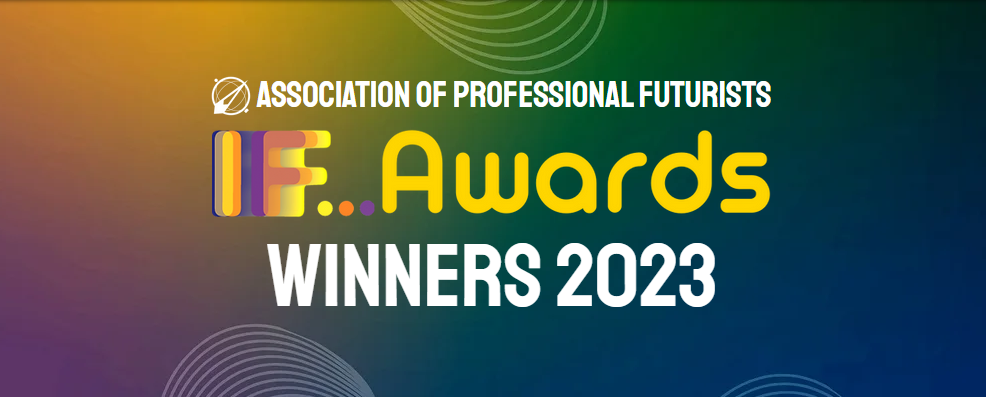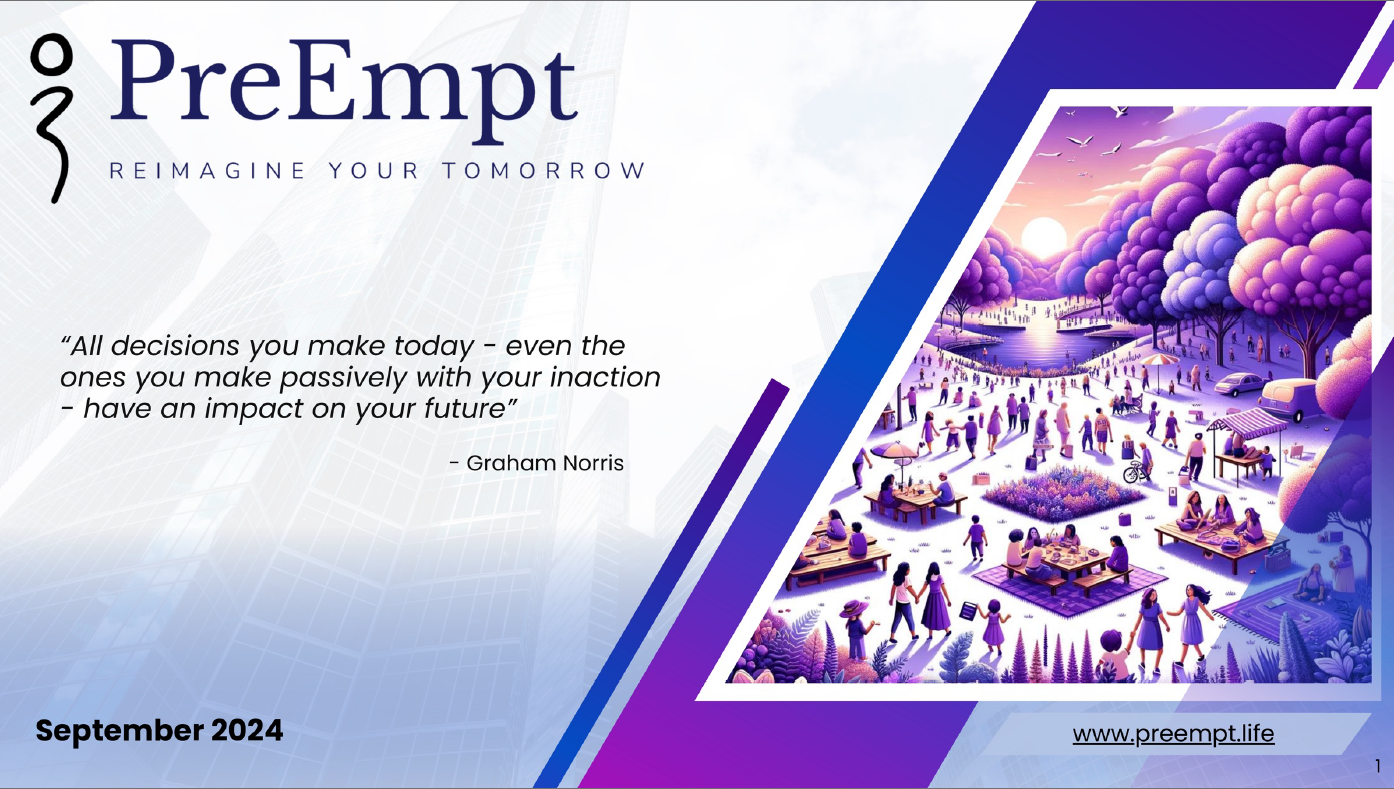
- Internationally recognized expert in strategic foresight, AI ethics, and decision intelligence
- Founder of PreEmpt.Life — the first participatory, AI-powered foresight and decision platform
- Former Chairman of Shaping Tomorrow and transformational CEO of Birmingham Midshires
- Senior leadership at Bank of America and Citibank, driving innovation and profitability
- Academic honors: BSc, MBA, and Honorary Doctorate in Business Administration
- Global advisor and speaker, known for pioneering ethical, human-centric AI
- Mission: Democratize strategic foresight to empower all organizations and individuals
- Leads PreEmpt.Life in enabling rapid, explainable insight across 1,000+ methods and futures

- Strategic leader at PreEmpt.Life, driving innovation in AI-powered foresight and decision intelligence
- Experienced digital strategist, critical thinker, futurist student, and published author
- Champions accessible, ethical AI for global organizations, SMEs, and individuals alike
- Oversees growth, cross-functional teams, and platform evolution to remain ahead of emerging challenges
- Also CEO of Digital Advantage, a marketing consultancy specializing in digital strategy and user experience
- Author of “The Ultimate Guide to Hosting International Guests”
- Mission: To empower informed, resilient futures through participatory foresight



- Blends technology and education, working with founders, scientists, and developers to build data-driven products.
- B.Tech in Mathematics & Computing from IIT Guwahati, batch of 2013.
- Instrumental in implementing analytics and decision-support frameworks for 200+ global firms.
- Expertise in AI, ML, optimization, predictive modeling, statistical modeling, big data, and approximation algorithms.
- Experience across industries: finance, healthcare, eCommerce, government, energy, retail, advertising, and more.
- Published research in ACM, IEEE, and other reputed journals on game theory, operations research, optimization, and network security.
- Born in Jamui, Bihar; lived and studied in Kolkata, Patna, Guwahati, Bangalore, Pune, and New Delhi.
- Interests include politics, traveling, adventures, cooking, movies, and innovation in technology and data science.










PreEmpt.Life earned prestigious recognition with an honourable mention at the esteemed Association of Professional Futurist IF Awards 2023. This global acknowledgment highlights our commitment to pioneering innovations in strategic foresight methodologies, addressing diverse and intricate challenges on a worldwide scale.
Click here to visit their website





Our Purpose
PreEmpt shares a real-time ‘self–others–system’ view of your future decisions, so you can dance with chaos instead of being dragged by it.
See Clearly. Decide Quickly. Act Boldly.
At PreEmpt.Life, we empower you to make intelligent decisions today, whether you’re leading a global business or launching a new local venture. Our unique decision intelligence platform helps you ask the right questions, then challenges assumptions, and refines your options, so you get insights you can trust and act upon.
Forward Thinking, For Everyone
We turn complexity into clarity and help you spot opportunities and avoid threats before they arise. Our technology adapts to your needs, your culture, and your goals; delivering a practical, actionable gameplan, and not guesswork.
Collaboration at the Core
Great decisions start with research. Our system surfaces blind spots, sparks new ideas, and brings every voice to the table, co-created by humans and artificial intelligence, so your path forward is informed, inclusive, and sustainable.
Ethics You Can See
Transparency is built in. Every answer is explainable, traceable, fair, and grounded in your values, allowing you to move ahead with confidence and integrity.
We're not here to predict the future. We're here to help you shape it.
Vision: Intelligent Decisions Today
PreEmpt.life aspires to be a globally trusted platform enabling rapid, responsible, and transparent decision-making for leaders and teams everywhere. The vision emphasizes explainability, accountability, sustainable impact, and collaborative intelligence, aligning with a governance-forward approach to Al-enabled foresight and strategy.
Values: TRUST
Transparency: Committing to openness, clear communication, and explainability in actions and decisions.
Responsibility: Accountability, integrity, and ethical stewardship in all activities.
Unwavering Curiosity: Continuous learning, probing questions, inovation and creative exploration.
Sustainability: Mindful resource use, long-term thinking, and ecological and social responsibility.
Teamwork: Self-Organization, co-creation, empowered teams, and effective self-management.
Principles:
Explainable governance: Every insight and recommendation is explainable, auditable, and traceable to criteria and values.
Ethical stewardship: Actions reflect integrity, social responsibility, and rigorous ethics reviews.
Continuous learning loops: The platform evolves with new data, questions, and perspectives to improve decision quality.
Sustainable impact: Decisions consider long-term ecological, social, and economic consequences.
Collaborative process: Decisions are co-created with human expertise and Al insights, ensuring inclusivity and shared ownership.
Global governance with local accountability: Scalable governance that respects regional regulatory nuances and client needs.
Evidence-based assurance: Maintain artefacts such as ethics reviews, risk registers, and audit reports, with continuous review and quarterly/annual independent verification.
Pricing Policy
We are pioneers in price competitiveness and value for money and seek to commoditise decision intelligence for the benefit of all, and not just for those with deep pockets. Our unique service outpaces all rivals and offers as follows:
Exclusive Findings
Strategic foresight reports with unique methodologies and proprietary data that competitors do not provide bring you instant, fully reasoned answers to your emerging challenges.
High-Quality Deliverables
The exceptional quality of the reports, including in-depth analysis and expert insights, puts you ahead of the curve.
Enhanced Customer Experience
We provide exceptional customer service, personalized consultations, and exclusive access to additional resources.
Strong Brand Identity
We are positioned and recognized as a leader in strategic foresight with a commitment to innovation and excellence.
Single reports at USD 360 each. Our rivals charge at least USD 30,000 for a lesser analysis and take many team months rather than the few hours our AI, Alexis, takes to produce a holistic answer, drawn from examining over 250 potential scenarios.
Private Client Sites
Fully functioning, private client sites can be made available within three working days at a cost of US Dollars 16000 per annum, including:
- Full security
- 2 licenses (More licenses available on request)
- A Private Challenge Library
- 24 reports per annum
- Visualizations
- Up to 1000 free My Life licenses for your stakeholders
- Full support from us
Meet Alexis - Your AI-Powered Strategic Twin
Alexis is the intelligent foresight engine behind PreEmpt.Life
Named for the Greek “Defender of the People,” she embodies leadership, insight, and protection; helping you plan ahead with clarity and confidence
Why Alexis?
Alexis is designed to support complex decisions in business, government, and society
- Live Insight: Ingests and contextualizes real-time data from internal, external, and third-party sources.
- Futures Simulation: Models plausible, probable, and improbable futures using predictive analytics (Bayesian, LSTM, GBM, Random Forest).
- Risk & Resilience: Anticipates bottlenecks, maps vulnerabilities, and flags early and weak signals of disruption.
- Strategic Clarity: Converts data complexity into visual outputs (causal knowledge graphs) that drive team alignment and action via gameplans.
- Sustainability & Impact: Projects environmental, social, and economic effects of choices over time.
How It Works
Alexis blends the power of LLMs with over 1,000 strategic frameworks and 5,000+ curated sources. She combines systems thinking, foresight tools, and complexity science to deliver a full-spectrum, 360° view of your challenge.
- Inputs: Your question (however complex), context, proprietary data, and priorities
- Processing: Data science, critical reasoning, scenario modeling
- Outputs:
- Strategy briefs, foresight PDFs, simulations
- Transparent reasoning, explainable AI
- Responses shaped by traits: Defending, Helping, Wise, Intuitive, Imaginative, Idealistic, Independent, Deep-thinking, Unconventional
Alexis continuously learns, invites human input, and explains her process; ensuring clarity, sustainability, ethics, and no ‘black-box’ guesswork
INTELLIGENT DECISIONS TODAY
At PreEmpt.Life, safety begins with clarity. Every insight, recommendation, and decision generated through our platform can be traced, explained, and validated via a transparent governance framework grounded in globally recognized standards from the UN, OECD-WEF, GDPR, and EU AI Act.
This ensures that every individual, team, or organization using PreEmpt.Life operates with principles of fairness, accountability, and respect that mirror the world's leading ethical systems.
We believe governance should serve people, not just processes.
Our mission is to design decision intelligence systems that are transparent, equitable, and accountable, reinforcing not only efficiency but also fairness, human dignity, and inclusion.
Our governance model invites participation from diverse voices — experts, workers, educators, and everyday citizens — to ensure that those most often excluded from technology debates have a real seat at the table.
We partner across sectors to build digital literacy and expand access to decision intelligence, empowering communities to understand and shape the systems influencing their futures. Central to our model is the Critical Friends Network — a rotating global panel of over 100,000 diverse participants, including lay people, frontline workers, domain experts, and social influencers.
For every significant scenario, PreEmpt.Life randomly selects a new panel to stress-test, refine, and challenge what the AI recommends. Acting as citizens, auditors, and advisors, these Critical Friends provide organizations with a defensible social mandate for their choices. Their discussions create an auditable trail of questioning, dissent, and refinement, which strengthens each outcome's legitimacy.
When Critical Friends raise concerns — about potential bias, unseen impacts, or equity issues — their insights feed directly into the PreEmpt.Life engine. AI weightings, risk factors, and scenarios are recalibrated, ensuring that future recommendations become more robust, explainable, and aligned with the public interest. This living form of explainable governance embeds scrutiny and structured dissent at scale, so oversight is not an afterthought but an active safeguard of fairness.
Humans remain at the heart of every loop. Expert reviewers collaborate with algorithms, continually testing data assumptions and outcomes to ensure that automated insights reflect lived reality, not abstract prediction. Our bias and safety protocols follow ISO- and NIST-aligned audits, catching inequities before they influence real-world decisions.
Data protection underpins everything. All personal data on PreEmpt.Life belongs unequivocally to the people who provide it.
Participation is voluntary, transparent, and retractable — contributors can withdraw or delete their data at any time. Information is never repurposed or shared without explicit consent, and all interactions are logged to ensure accountability.
System access is tightly controlled, storage is encrypted and redundantly backed up, and any incident is reported immediately under independent oversight. To date, no breach has occurred — a reflection of both our vigilance and our culture of care.
Beyond compliance, PreEmpt.Life views governance as a living practice — adaptive, ethical, and human. By uniting explainable AI, participatory oversight, global standards, and digital justice into one framework, we create trust you can see — trust that scales with the complexity of modern decision-making. In this environment, innovation and integrity move forward together, keeping people and stakeholders safer every step of the way.
Ask Perplexity and Interrogate its full analysis of us!
Clustre Event Featuring Our President
We recognize here the many amazing futurists strategists and change agents (the titans) work in creating the methods that are embedded in our compendium system. Plus, many associates and friends who freely gave their time, knowledge and resources to bring the system together. Thank you all.
PreEmpt Showcase in The Future Now Show
Dr. Mike Jackson discusses the growth of his AI-driven foresight company, PreEmpt, highlighting how its system analyzes data to deliver strategic insights and recommendations. He emphasizes its role in transforming decision-making, addressing challenges across sectors, and its focus on security, cultural adaptability, and future innovation.
FuturePodcast on PreEmpt capabilities
April 2024
Reimagining Tomorrows; Reimagining Foresight: An Inside Look at the PreEmpt Platform
PreEmpt was recently featured on the Association of Professional Futurists Website. Click here to view the article.
The Future, Faster and Deeper: Why the Invictus-PreEmpt Synergy Is a Strategic Game-Changer
PreEmpt was recently featured on a LinkedIn post by Foresight Driven Insights. Click here to view the article.
-
PreEmpt.Life Launches Revolutionary Platform to Democratize Decision Intelligence and Strategic Foresight Worldwide – “Reimagine Your Tomorrow."
By Binary News Network - Digital Journal - December 9, 2024
PreEmpt.Life Launches Revolutionary Platform for Decision Intelligence & Strategic Foresight
By PR Log - Press Release Distribution at prlog.org - February 24, 2025
- Company Name: PREEMPT.LIFE LTD
- Registered Office Address: 124–128 City Road, London, EC1V 2NX, England
- Company Registration Number: 16402220
- Incorporation date: 23 April 2025
- Registered in England and Wales
- DUNS Number: 23-373-3231
-
Alan Gates - CEO/Managing DirectorContact: +44 7791 745 088
-
Michael Jackson - Founder and Non-Executive DirectorContact: +44 7722 009 588
-
Melanie Dugay - Company SecretaryContact: +63 0945 4280
As of December 13th, 2025
-
v2.1.1
- Real-Time, Free Instant Alerting and Horizon Scanning with Automated Scenario Creation and Preemption Recommendations.
- Delivers real-time monitoring and detection—instantly alerts all members, free of charge, to early worldwide threats, weak signals, and emerging opportunities.
- Instantly generates automated scenarios for each alert, letting users envision impacts and choose effective, preemptive actions before escalation.
- Includes tailored preemption strategies for every alert and scenario, empowering individuals and teams to act defensively or opportunistically as needed.
- Any registered member can trigger or collaborate with alert-driven, scenario-based planning and preemptive action at any time.
- Client search query customization.
- Dashboard for Trust, Audit, Compliance, Nutrition Labels, and Faith Score
- Provides at-a-glance, transparent metrics for trust, audit, global compliance, explainability (“Nutrition Labels”), and reliability/ethical alignment (“Faith Score”) for every key outcome. PreEmpt.life now leads all comers on all Decision Intelligence/Strategic Foresight performance metrics.
- Critical Friends and Contextual Insights (100,000+ Human and Non-Human Agents, Randomly Selected Per Task)
- Leverages human experts, professionals and lay people, and non-human reviewers (AIs, bots, simulations), randomly selects 10,000 per task to ensure maximum independence, diversity, and impartial assessment for every decision or scenario. Critical Friends multi-task as citizens, juries, laboratory assistants, auditors, and advisors ...
- Free Education for All
- Delivers universal, open-access education in decision intelligence, strategic foresight, critical and systems thinking, and scenario planning—all within the workflow at zero cost to users. (Early version which will lead to full gamification and certfication, and a student option to select a linked interest domain).
- Learning and skill development are now integrated into every platform experience, so anyone, anywhere, can build future-ready capabilities without formal requirements or financial barriers.
- Interoperability
- Professional third party open datasets (viewable by all) and closed private client databases (viewable only by the client) now in situ.
- Readability Levels for Ages 12+ on up
- All outputs and guidance are crafted for accessibility at a 12+ reading age, ensuring inclusivity for multi-generational groups, youth, and novices and can be reset for members educational level.
- Technical and UX Improvements
- Includes streamlined interfaces, natural language Ask Free Question, Jobs-to-be-Done work flow (Scan>Plan>Act>Lead>Govern), enhanced search, feedback, skill profiling, policy tools, and dispute resolution features.
- New Tools
- We are grateful to Gill Ringland and Patricia Lustig for asking us to digitize their new Possibiity Wheel co-creation method.
- PreEmpt.Life now stands out as a real-time, alert-driven, fully participatory platform—delivering anticipatory action, transparent benchmarks, unbiased review, and universal, free education for all, making collective intelligence accessible everywhere on tap.
- API
- Clients can now use APIs to export their answers to Claude, Perplexity, Anthropic, and to other third party applications, and to their own inhouse systems if desired.
- Next steps in 2026
- Infrastructure upgrade
- Gamification layer
- Laboratory capabilities
- Extended and improved education to Master's level
-
v1.11.1
- A new Dashboard now compares key measures against global performance including public trust assessments, citizen jury reviews, and an independent audit.
- UX improvements now allow preselection of your 'job to be done' today, simplifying outputs.
- Unique assessments now include 10,000 diverse and distributed Critical Friends (Lay people, Workers, Experts/Influencers) critiquing all recommendations: expressing their agreements, nuanced opinions, and disagreements, and expressing opportunities for improved outcomes.
- More Regional, Generational, and Lessons Learned Analysis.
-
v1.10.3
- Added internet search in question form
- Text updates in Policies Page
-
v1.10.2
- Added "Skills" in Profile
- Added Feedback rating using slider
-
v1.10.1
- Added "Data Collection" section in Profile
- Added new content in Media Page
- Added "Financial Services" case study
- Added "Disputes" section in Policies
- Text Updates
- Fixed bug in search function
-
v1.10.0
- Enabled Internet Search during Answer Generation
-
v1.9.0
- Implemented Knowledge Graph Node Search
- Implemented Save Draft function in the Question form
- Fixed reorder function in public answer viewing page
-
v1.8.13
- Added new search function to the Answer viewing pages
- Fixed the bugs in the Reorder Function
- Added new text in the Policy Section of the Profile Page
- Updated text labels
- Added "Google Meet" to "Apps"
- Removed/hidden unnecessary UI elements
-
v1.8.12
- Inclusions field is visible in the Question Form
-
v1.8.11
- Improved the Shared Answer Viewing Page to correctly display both Insights and Evidence
-
v1.8.10
- Updated UI for the Shared Answer Viewing Page
- Text Updates
- Updated logo
- Added new media
-
v1.8.9
- Updated UI for the Main and Public Answer Viewing Pages
-
v1.8.8
- Added "College Strategy" case study
- Added 'Farsi' as an option in the language dropdown menus
- Text Updates
-
v1.8.7
- Text Updates
- Added new Global Ambassadors
-
v1.8.6
- Added a new export button in all of the Answer viewing pages
-
v1.8.5
- Added "Critical Thinking" to Policies
-
v1.8.4
- Added "More Services" to About Us
-
v1.8.3
- Text Updates
- Added "More Services" to About Us
-
v1.8.2
- Bug Fixing and Optimization
- Update Policies > Validation
-
v1.8.1
- Added ISC as partner
- Bug Fixing and Optimization
-
v1.8.0
- Visualization is added when ordering a report
- Added Checkout page
- Updated Reasoning to Scenarios
- Added Policies > Agents
- Text Updates
- Bug Fixing and Optimizations
Coming Soon
| Project | When |
|---|---|
| First advanced predictive analytics | Early next year |
| Comparisons over time, versus rivals | Early next year |
| Advanced Courses | Early next year |
| Auto reporting | Early next year |
Previously This Year
Harnessed historical data and current methods to build robust decision-making frameworks. Focus on correcting AI biases and errors was a primary driver.
Integrated diverse systems, design, strategy, foresight, and critical thinking methodologies, emphasizing adaptive strategies and the use of interdisciplinary insights to tackle complex global challenges.
Embedded inclusivity, diversity, and ethical considerations across PreEmpt.
Fully developed and synchronized decision intelligence systems that prioritize planetary health and ecosystem sustainability, aiming for harmonious human-nature co-existence.
First Course
Public Surveys
Auto Alerting
Shopping List
- Develop scalable decision intelligence platforms by 2026
- Achieve industry-leading benchmarks for ethical AI integration by end 2025
- Foster partnerships that drive cross-sector innovation
- Enhance stakeholder engagement through proactive communication and education initiatives
Our Strategy
1.1 OBJECTIVE :
Optimize our technological and strategic framework to make it the most advanced decision intelligence system in the world.
1.2 HEADLINES :
Headline: Transformative Horizons in Decision Intelligence
-
H0 | Unifying Foundations (Past and Current):
Decision Intelligence has historically focused on integrating AI with strategic decision-making processes, leveraging data analytics to reduce biases and enhance accuracy. Recent developments emphasize methodological transparency and stakeholder integration, setting a strong base for future transformation.
Rating: 3.8
-
H1 | Adaptive Transition (Short-Term, Next 2 Years):
The focus shifts toward rapid adoption of advanced AI methodologies, refining foresight tools, and enhancing real-time data analysis. Key strategies include developing ethical frameworks and increasing cross-disciplinary collaboration to tackle immediate challenges.
Rating: 4.1
-
H2 | Strategic Evolution (Medium-Term, 3-10 Years):
Decision Intelligence will be characterized by seamless integration of predictive analytics and bespoke solutions tailored for various industries. Innovations will highlight sustainability and global adaptability, driven by rigorous algorithmic development and innovative design thinking.
Rating: 4.5
-
H3 | Intelligent Ecosystems (Long-Term, 11-20 Years):
An era of smart, autonomous systems that anticipate market needs and environmental shifts. Decision Intelligence will evolve into ecosystems that drive proactive change, supported by continuous learning and strategic foresight embedded at systemic levels.
Rating: 4.7
Framework:
-
Structure:
Organize around cross-functional teams to ensure agility, with a clear hierarchy to facilitate efficient communication and decision-making processes.
-
Systems:
Implement robust analytics platforms that enable real-time data processing and predictive modelling, ensuring methodological transparency and system integration.
-
Style:
Foster a culture of innovation and openness to change, encouraging feedback and adaptive learning to navigate and capitalize on uncertainties.
-
Staff:
Recruit and develop interdisciplinary talent skilled in AI, analytics, strategy, and sustainability, promoting an inclusive and diverse environment.
-
Skills:
Enhance competencies in predictive analytics, strategic foresight, adaptability in volatile environments, and stakeholder engagement.
Strategy Choice Cascade:
-
Welcome and Use Uncertainty for Good:
Embrace uncertainties by creating flexible strategic frameworks that allow rapid response to unforeseen changes. For example, in technology sectors, anticipate disruptive innovations and adapt quickly to retain market leadership.
-
Pick the Willing:
Engage early adopters and innovators within the organization who are enthusiastic about driving change.
-
Lean into the Future:
Proactively explore future scenarios and leverage them to inform strategic choices.
-
Kill Sacred Cows and Wasted Efforts:
Identify outdated processes and technologies, replacing them with more efficient alternatives.
-
Organize for Success:
Align organizational structure to support innovation and speed.
-
Build Capacity:
Invest in training and development to keep teams skilled and ready for future challenges.
-
Encourage Dynamic Spillover:
Facilitate cross-industry collaborations to expand influence and capabilities.
-
Co-create Tomorrow:
Engage stakeholders in collaborative visioning exercises to shape strategies.
-
Constant, Consistent Communication:
Maintain open dialogues with stakeholders through transparent communication channels.
-
Reinforcing Actions and Buy-in Discussions:
Use workshops and forums to discuss and reinforce commitment to strategic objectives.
Next Steps:
-
Operationalize the Strategy:
Implement a comprehensive plan that aligns daily operations with strategic objectives.
-
Adapt and Iterate:
Continuously review and refine strategies based on new insights and feedback.
-
Engage Stakeholders:
Include diverse voices in strategic discussions to build broader consensus and enrich perspectives.
-
Deploy Resources Efficiently:
Prioritize key initiatives and allocate resources to areas with the highest strategic impact.
-
Monitor Progress:
Establish metrics to track progress and make adjustments as necessary.
In conclusion, by adopting these strategic and operational frameworks, organizations can effectively navigate uncertainty and drive growth and innovation in alignment with their vision and mission.
1.4 FRAMEWORK :
| Time Horizon | Key Recommendation | Potential |
|---|---|---|
| H0 | Leverage current technologies and strategies to enhance transparency and reduce biases within decision-making systems. Focus on refining existing frameworks and engaging stakeholders to build trust. | P2 |
| H1 | Integrate cross-functional teams to foster agility and quick adoption of AI methodologies. Develop ethical frameworks to guide AI application and decision-making processes. | P2 |
| H2 | Invest in AI-driven bespoke solutions tailored for industry-specific challenges, emphasizing sustainability and adaptability. Strengthen predictive analytics capabilities through collaboration with research institutions. | P1 |
| H3 | Foster intelligent ecosystems that anticipate and respond to market and environmental shifts. Enable continuous learning and strategic foresight to be embedded at systemic levels. | P1 |
| H4 | Create a harmonized and ubiquitous Decision Intelligence network that addresses global disparities, optimizing worldwide decision-making and fostering a sustainable future. | P1 |
1.5 ORGANIZATION :
Modern Operating and Business Model for Decision Intelligence
Guiding Principles
- Agility and Flexibility: Embrace adaptive methodologies to respond swiftly to changes and opportunities.
- Sustainability and Ethics: Incorporate sustainable practices and ethical considerations in decision-making processes.
- Stakeholder Inclusivity: Engage diverse stakeholders to ensure multi-perspective insights and decision inclusiveness.
- Data Integrity: Maintain high standards of accuracy, privacy, and transparency in data handling.
- Innovation and Disruption: Foster a culture of continuous innovation and readiness to disrupt traditional models.
Organizational Structure
- Flat Hierarchy: Develop cross-functional teams with decentralized decision-making powers to enhance agility and responsiveness.
- Networked Teams: Promote collaboration across disciplines and geographies to harness collective intelligence.
- Role Fluidity: Encourage role adaptability to leverage multi-disciplinary skills, aligning with evolving strategic needs.
Processes
- Continuous Feedback Loops: Implement iterative processes that integrate stakeholder feedback and market insights into strategy adjustments.
- Agile Project Management: Use Scrum or Kanban methodologies for quick turnaround and adaptability.
- Holistic Decision Frameworks: Integrate systems thinking to evaluate decisions based on interconnected impacts and feedback loops.
Technology
- Advanced AI and Analytics: Invest in cutting-edge AI technologies for predictive analytics and automated decision support.
- Cloud-Based Platforms: Enable seamless data sharing and collaboration through scalable cloud solutions.
- Cybersecurity: Prioritize robust security measures to safeguard sensitive data and uphold stakeholder trust.
People and Culture
- Interdisciplinary Skills: Attract and develop entrepreneurial, adventurers with diverse skill sets, bridging technology, strategy, and ethics.
- Diversity and Inclusion: Cultivate an inclusive environment that values varied perspectives and fosters innovation.
- Learning and Development: Promote continuous professional development and learning opportunities.
Data-Driven Focus and Accessibility
- Data Democracy: Ensure data accessibility across all organizational levels to empower decision-making.
- Analytics Literacy: Equip teams with data literacy skills to harness data effectively in strategic contexts.
- Visualization Tools: Use intuitive visualization software to enhance insights and stakeholder engagement.
Chain of Command
- Empowered Teams: Grant decision-making autonomy to teams, reducing bottlenecks associated with hierarchical approval processes.
- Strategic Oversight: Maintain strategic coherence through clear guidance from senior leadership while empowering lower levels.
Alignment through OKRs
- Objective Setting: Clearly define aspirational objectives that align with long-term vision and values.
- Key Results Measurement: Establish quantifiable key results to track progress and pivot strategies as needed.
- Transparency and Engagement: Foster transparency in OKR processes to enhance team engagement and accountability.
Continuous Progress Reviews
- Iterative Assessments: Conduct regular reviews to assess progress and align objectives with evolving external conditions.
- Adaptive Adjustments: Adjust strategies and resources based on performance data and market shifts.
- Celebrating Success: Recognize achievements and reinforce positive outcomes to motivate ongoing effort.
Outdated Management Systems to Abandon
- Rigid Hierarchical Structures: Avoid silos and centralized control to embrace flexible, empowered teams.
- Top-Down Decision Making: Encourage inclusive, collaborative decision-making frameworks that leverage diverse insights.
- Fixed Mindset Planning: Discard static planning models in favor of dynamic, scenario-based strategic planning.
Actions
- Increase: Focus on enhancing stakeholder collaboration, interdisciplinary talent development, and adaptive strategic planning.
- Start: Invest in AI and data transparency initiatives; promote continuous learning and capacity expansion.
- Reimagine: Strategic decision frameworks that incorporate sustainability and ethics alongside business metrics.
Best Methods to Deliver Transformative Change
- Lean and Agile Practices: Adopt Agile and Lean management principles for rapid iteration and stakeholder alignment.
- Open Innovation Platforms: Leverage platforms that encourage open innovation and partnership beyond organizational boundaries.
- Scenario Planning and Simulations: Use advanced scenario planning to anticipate and prepare for future uncertainties.
- Change Management Programs: Implement robust change management to guide cultural and operational transformation.
By emphasizing a modernized operating and business model that leans into strengths while avoiding outdated structures, we can effectively deliver on the promise of Decision Intelligence, driving strategic and transformative change.
1.6 SCORECARD
Balanced Scorecard
-
1. Financial Perspective
Objective: Increase Revenue from Decision Intelligence Solutions
-
Measure: Percentage Growth in Revenue
-
Targets: Achieve a 50% annual increase in revenue over the next three years
-
Initiatives:
- Expand product offerings tailored to industry-specific needs
- Develop strategic partnerships with key industry players
- Invest in targeted marketing campaigns to penetrate new markets
-
-
2. Customer Perspective
Objective: Enhance Customer Satisfaction and Retention
-
Measure: Net Promoter Score (NPS)
-
Targets: Achieve an NPS of 95 by the third year
-
Initiatives:
- Implement a comprehensive customer feedback system
- Establish a dedicated customer success team
- Improve human experience through regular software updates
-
-
3. Internal Process Perspective
Objective: Optimize Decision Intelligence Operations
-
Measure: Efficiency Ratio (Cost to Serve vs. Customer Value)
-
Targets: Reduce operational costs by 15% while maintaining customer value
-
Initiatives:
- Enhance process automation and streamline workflows
- Leverage AI technologies for predictive maintenance and service delivery
- Conduct periodic reviews of internal processes and adopt best practices
-
-
4. Learning and Growth Perspective
Objective: Foster Innovation and People Development
-
Measure: People Skill Levels
-
Target: Achieve a 20% increase in skills certification among people
-
Initiatives:
- Launch an internal innovation program with incentives for new ideas
- Establish partnerships with academic institutions for research collaborations
- Provide continuous learning and development opportunities for staff
-
By following these objectives, metrics, targets, and initiatives, we can systematically and effectively advance in decision intelligence, align its operations with strategic goals, and maintain a leadership position in the market.
1.7 INNOVATION
Top Three Potential Design Changes in Decision Intelligence
-
1. Enhanced Human Experience through Simplified Interfaces
Advancing the human experience by redesigning interfaces that prioritize simplicity, intuitiveness, and responsiveness. This involves leveraging modern UI/UX principles and human-centered design to create interfaces that cater to users at various skill levels. By doing so, decision-makers can interact with complex data more seamlessly, enhancing engagement and facilitating real-time insights.
Assessment of Potential: This change is preferable as it provides immediate functional improvements, elevating user satisfaction and adoption rates without extensive technological overhauls.
-
2. Integration of Augmented Intelligence Features
Embedding augmented intelligence into existing systems can enhance human decision-making by providing contextual insights and recommendations without replacing the decision-maker. This involves incorporating natural language processing (NLP), sentiment analysis, and machine learning algorithms to offer proactive suggestions and highlight potential biases.
Assessment of Potential: This change is both preferable and possible, as it furthers the goal of enhancing decision quality without extensive disruption and matches current trends towards augmented intelligence.
-
3. Adoption of Modular and Open Architecture
Transitioning to a modular architecture allows for greater flexibility and scalability, where system components can be independently developed, implemented, or updated. Open standards and APIs enable seamless integration and collaboration with external tools and platforms, fostering innovation and adaptability.
Assessment of Potential: This change is possible and critical for long-term sustainability, offering interoperability and facilitating continuous innovation adoption.
Quick Wins: Low-Cost or No-Cost Advantages
-
1. Data Visualization Workshops
Implement workshops aimed at improving skills in using existing data visualization tools. This empowers teams to better interpret and communicate data-driven insights, enhancing decision-making efficacy with minimal investment.
Advantages: Quick skill enhancements increase data literacy and are cost-effective given existing tool availability.
-
2. Internal Knowledge Exchange Programs
Facilitate cross-departmental knowledge-sharing sessions focused on best practices and innovative strategies already in use within the organization. This can be done virtually to minimize expenses while maximizing intellectual capital exchange.
Advantages: Fosters a culture of continuous learning and collaboration, enhancing operational processes using accessible resources.
-
3. Open Feedback Channels
Establish direct feedback mechanisms, such as digital feedback forms, to gather real-time input from users and stakeholders regarding the system’s performance. This can lead to incremental, user-driven improvements without significant financial commitment.
Advantages: Encourages user engagement and offers valuable insights into areas for refinement that align with user expectations and needs.
These initiatives represent strategic moves that provide substantial value with limited financial outlay, rapidly catalyzing enhancements that align with the vision of making us the leading decision intelligence system.
1.8 ACTIONS
Top Three Required Cultural Changes and Associated Recommendations
-
1. Embrace a Culture of Innovation and Experimentation
-
Start: Foster an environment where creative ideas are encouraged and actively pursued. Implement "innovation sprints" where teams can work on new ideas with tangible support from leadership.
-
Stop: Encourage risk-taking as a component of the growth process rather than a perilous endeavor.
-
Continue: Maintain a commitment to leveraging innovative technologies like AI and machine learning to enhance decision intelligence capabilities.
Recommendations: Establish an 'Innovation Lab' where cross-disciplinary teams can pilot new projects with access to resources and mentorship. Promote a mindset shift where every employee views themselves as a potential innovator, contributing to the larger strategic goals.
-
-
2. Cultivate Inclusive Decision-Making
-
Start: Actively include varied perspectives in decision-making processes to ensure a comprehensive approach. Use tools and platforms to gather input from all organizational levels.
-
Stop: Avoid hierarchical communication barriers that obstruct open dialogue and suppress diverse ideas.
-
Continue: Support broad-based training in areas like cultural competence and inclusive practices.
Recommendations: Implement frameworks that ensure decision-making bodies represent diverse voices within the organization. Facilitate workshops on unconscious bias and cultural sensitivity to deepen understanding and avoid silos.
-
-
3. Drive Data-Driven Decision Culture
-
Start: Develop and enhance data literacy programs across the organization to empower data-driven decision-making. Ensure all teams have access to actionable insights.
-
Stop: Avoid decisions based solely on intuition without empirical backing. Move away from gut-based management approaches.
-
Continue: Promote the use of advanced analytics and data visualization tools to transform raw data into strategic insights.
Recommendations: Integrate data-driven KPIs into performance assessments, tying decision outcomes to measurable data. Highlight and celebrate scenarios where data-driven decisions led to organizational success, reinforcing their value.
-
Singular Biggest External Roadblock and Overcoming It
-
Roadblock: Regulatory and Compliance Challenges
The rapid evolution of AI and data regulations poses hurdles in keeping systems compliant and secure. These regulatory changes can slow decision intelligence implementation and innovation across the organization.
-
Strategy to Overcome: Proactively engage with legal experts and stakeholders in the field to stay ahead of regulatory changes. Develop a dedicated governance and compliance task force to monitor, assess, and advise on regulatory adherence. Foster partnerships with industry bodies and policymakers to inform ongoing developments and ensure our interests and capabilities are represented in regulatory discussions.
Rewarding Success and Penalizing Roadblocking
-
Rewards for Success:
- Implement performance rewards linked to sales income.
- Provide public recognition and career advancement opportunities for employees who contribute significantly to strategic successes.
- Offer personal development incentives such as training or education allowances.
-
Penalizing Roadblocks:
- Enforce accountability measures for repeated blockers of strategy implementation, including performance reviews and remedial coaching.
- Establish clear guidelines and escalation processes to address and resolve obstacles effectively.
- Encourage a culture of constructive feedback to identify roadblocks and develop improvement strategies collaboratively.
Price of Inaction
Failing to instigate these cultural changes risks stagnation in innovation, competitive setback, and missing the opportunity to lead in decision intelligence. It may result in talent attrition, operational inefficiencies, and potential market irrelevance as competitors who adapt continue to advance rapidly.
1.9 GAPS : Spot the Blind Spots and Evaluate Possible Solutions
Gaps, Roadblocks, and Barriers in Delivering a Successful Strategy
-
1. Technological Integration and Scalability
-
Gap: Integrating new technologies with existing systems and scaling them efficiently.
-
Solution: Develop an agile integration framework that allows for modular updates and gradual scaling. Encourage the use of interoperable platforms and standardized APIs to facilitate smoother transitions and scalability.
-
-
2. Resistance to Change
-
Roadblock: Cultural inertia and resistance within the organization might hinder adoption.
-
Solution: Implement change management practices, including clear communication of benefits, training programs, and involving employees in the decision-making process to foster a sense of ownership and reduce resistance.
-
-
3. Data Privacy and Security
-
Barrier: Rising concerns about data privacy and security risks with advanced decision intelligence.
-
Solution: Enhance cybersecurity measures by adopting best practices, including encryption, data anonymization, and regular security audits. Develop transparent data policies to build trust with stakeholders.
-
Potential Unforeseen Challenges and Meaningless Rabbit Holes
-
Challenge: Misalignment between strategic objectives and operational execution.
-
Mitigation: Use continuous feedback loops, like PDCA cycles, to ensure alignment and allow for timely adjustments.
-
-
Rabbit Hole: Over-investing in niche technologies that do not add substantial value to the core mission.
-
Mitigation: Prioritize investments that focus on technologies that align with long-term strategic goals.
-
Other Ways of Knowing
-
Holistic Paradigms: Indigenous knowledge systems and environmental stewardship can offer valuable insights, often found through collaborations with cultural anthropologists or ecological experts.
-
Practical Wisdom (Phronesis): Gained through experiential learning and reflective practice, often disseminated via mentorship programs or community-based learning initiatives.
Cultural Implications and Sustainability
-
Implications: Promoting inclusivity in decision intelligence design supports diverse cultural values and perspectives, enhancing global understanding and cooperation.
-
Sustainability: Ensure that solutions align with environmental and social sustainability principles by incorporating lifecycle assessments and circular economy practices.
Overcoming Barriers to Success
-
Engage in transparent communication about the benefits and potential impacts of strategies to gain stakeholder buy-in.
-
Implement ethical nudges, such as framing success stories and setting social norms, to encourage stakeholder alignment.
Roles of Indirectly Associated Sectors
-
Collaborative Innovation: sectors like academia, civil society organizations, and startups to collaborate on innovative solutions, fostering cross-pollination of ideas.
-
Advocacy and Standards: Partner with regulatory bodies to establish industry standards and advocate for policies that promote ethical and sustainable decision intelligence practices.
Ensuring Sustained Involvement and Engagement
-
Stakeholder Involvement: Develop inclusive processes that integrate regular consultations with diverse stakeholders, using surveys and focus groups to gather input and adjust strategies accordingly.
-
Community Engagement: Create participatory platforms where stakeholders can contribute insights and feedback. Employ social media and online communities for broader engagement.
Achieving Satisfaction for All
To ensure satisfaction across different stakeholder groups, balance competing interests through equitable distribution of benefits, transparent decision-making processes, and fostering a shared vision of success.
1.10 BENEFITS : High-Level Analysis of the Top Benefits of the Reimagined Strategy
-
1. Enhanced Decision-Making Accuracy and Speed
The implementation of state-of-the-art data analytics and machine learning algorithms promises improved decision-making accuracy and speed. By reducing cognitive biases and leveraging predictive analytics, decision-makers can achieve more reliable outcomes faster. These capabilities position us as a frontrunner in the competitive landscape of decision intelligence.
-
2. Increased Organizational Agility and Adaptability
Through modular and scalable systems, the strategy ensures that we can rapidly respond to changing market dynamics and technological advances. This flexibility supports continuous innovation, allowing the organization to remain competitive and relevant in an ever-evolving environment, and in any economic environment.
-
3. Improved Stakeholder Engagement and Inclusivity
By fostering a culture of inclusivity and transparency, stakeholders become more engaged and invested in the organization’s success. This involvement leads to richer data inputs and more comprehensive decision-making processes, contributing to broader acceptance and implementation of decisions.
-
Minimizing or Eliminating Top Risks and Threats
-
Risk: Data Privacy and Security Concerns
Mitigation Strategy: Develop robust data governance policies that prioritize human consent and transparency. Implement cutting-edge cybersecurity measures, including end-to-end encryption and real-time anomaly detection systems. Regular audits and compliance checks with international data protection standards will help maintain human trust and regulatory alignment.
-
Risk: Resistance to Technological Adoption
Mitigation Strategy: Initiate comprehensive change management programs focusing on human education and engagement. Highlight the tangible benefits of the new systems through pilot programs and success stories. Providing clear, ongoing support and training will facilitate smoother transitions and increased acceptance.
-
Risk: Technological Obsolescence
Mitigation Strategy: Invest in continuous research and development to stay abreast of technological trends and innovations. Encourage partnerships with tech startups and universities for collaborative advancements, ensuring access to cutting-edge know-how and tools.
-
Closing Thoughts
To establish us as the pinnacle of decision intelligence systems globally, the strategic emphasis must remain on integrating advanced technologies, fostering an inclusive culture of innovation, and ensuring robust data governance practices. These efforts will not only enhance operational efficiencies but also build stronger stakeholder relationships, driving sustained success.
Created by our AI: https://www.preempt.life/report/public_view.html?synthesisId=mleqwjrtlv, Tweaked by our management, and approved by our Board of Directors - November 2024
PreEmpt.life is your strategic partner in navigating change. Our Change Management Advisory Consultancy is designed to guide organizations through transformation with clarity and efficiency. We offer tailored solutions that address your unique challenges.
Our experienced consultants work closely with you to identify areas of improvement, design actionable strategies, and implement processes that enhance adaptability and resilience. At PreEmpt.life, we prioritize clear communication and stakeholder engagement to ensure seamless transitions. We empower teams through training and support, fostering a culture of continuous improvement and collaboration.
Trust us to help you manage the complexities of change. Our approach is focused on achieving tangible results, minimizing disruption, and maximizing potential. Embrace change confidently with PreEmpt.life. Contact us today, to learn how to quickly establish, run and complete your project in record time and at ultra low cost with super smart, reimagined outcomes.
PreEmpt.life opens the door to transformative learning by empowering individuals to partake in cross-disciplinary projects seamlessly. By fostering an environment where diverse fields converge, we enable innovative thinkers like you to blend ideas, methods, and skills from various disciplines, driving forward real-world solutions.
Collaborate with public, private, and non-profit organizations to pool resources and address "wicked problems" like climate change, public health crises, and digital equity. With PreEmpt.life, you access tools and resources that facilitate collaboration and creativity beyond traditional boundaries. This is your platform to experiment within a vibrant community, engage with experts from different areas, and develop projects that impact industries and societies alike.
Our framework encourages this cross-pollination of ideas, giving you the chance to discover connections between fields, whether it’s blending science with art, technology with sociology, or engineering with ethics. These interdisciplinary projects don’t just broaden skills; they broaden perspectives, fostering advancements and fresh solutions in today’s complex world.
Join PreEmpt.life to harness this boundless potential. Here, your innovative projects carve new paths, inspiring change and opening possibilities you’ve only dreamed of. Collaborate, create, and lead the future with us. Contact us today, to learn how to quickly establish, run and complete your project in record time and at ultra low cost with super smart, reimagined outcomes.
Elevate your future at PreEmpt.life with our transformative courses in Strategic Foresight, Design, Systems, and Critical Thinking. Our programs are tailored to build your skills and prepare you to navigate and lead in an evolving landscape. We have developed online courses and/or workshops that teach you about systems thinking, strategic foresight, and interdisciplinary approaches. These uniquely can include a fully worked study on an interest topic of your choice.
Our Strategic Foresight course empowers you to anticipate and prepare for emerging trends. Learn to analyze and adapt, turning uncertainty into opportunity. With our Design course, unleash your creativity and innovation. Gain practical skills to design impactful solutions that address real-world challenges.
Master Systems Thinking with our comprehensive approach. Enhance your ability to see interconnected patterns, enabling you to develop sustainable strategies and solutions. Sharpen your Critical Thinking skills for deeper analysis and better decision-making. Our course equips you with the tools to question assumptions and drive meaningful change. Acquire the knowledge to foresee and shape the future. Transform your potential into action and lead with confidence.
Contact us today, to learn how to quickly establish, run and complete your project in record time and at ultra low cost with super smart, reimagined outcomes.
Explore the future with My Life by PreEmpt.life, where trend-spotting meets actionable insight. Our platform empowers individuals and businesses to identify emerging trends and adapt with agility. Stay ahead with our comprehensive analysis of shifting public dynamics and behaviors.
My Life provides you with the tools to observe, interpret, and respond to trends before they fully evolve, ensuring you remain relevant and proactive. We help you decode the complexities of market signals and societal shifts. With intuitive resources and expert guidance, My Life equips you to anticipate changes and seize opportunities, turning foresight into strategic action.
My Life by PreEmpt.life transforms your trend-spotting ability into a powerful skill, enabling you to shape your future dynamically and effectively. Contact us today, to learn how to quickly establish, run and complete your project in record time and at ultra low cost with super smart, reimagined outcomes.
PreEmpt.life invites you into a world of relentless reimagination.
Discover dynamic social networking and innovative problem-solving with PreEmpt.life through Imaginarium.io. Our platform connects people who are eager to collaborate, create, and solve real-world challenges. Harness the power of a vibrant community where ideas flourish. Imaginarium.io offers a space to share insights, brainstorm solutions, and turn concepts into reality. Engage with experts and peers to tackle issues across various domains, enhancing your problem-solving skills. Our tools and resources are crafted to inspire creativity and practical thinking. Whether you’re addressing social, environmental, or business challenges, Imaginarium.io provides the support and network you need to thrive.'
Join Imaginarium.io to unlock your potential, foster impactful change, and contribute to meaningful solutions. Engage with purpose, innovate with passion, and transform ideas into action. Contact us today, to learn how to quickly establish, run and complete your project in record time and at ultra low cost with super smart, reimagined outcomes.
PreEmpt.life invites you into a world of relentless innovation through our dynamic innovation labs. Here, limitless creativity meets purpose-driven experimentation, giving you the tools and environment to transform ideas into reality. Our innovation labs are unique spaces designed to fuel continuous development and invention. With a focus on practical application and real-world impact, these labs are where your curiosity and skills collide with opportunity. Dive into an ecosystem that supports constant growth, collaboration, and cutting-edge technology.
At PreEmpt.life, you don’t just conceive ideas—you refine and implement them. Collaborate with other forward-thinkers, leverage insights from different fields, and drive projects that push boundaries and inspire change. In our innovation labs, learn, experiment, and innovate continuously, without the constraints of traditional systems. Join us to unlock your potential in a setting that champions progress and evolution.
Experience how PreEmpt.life can catalyze your journey of innovation, making new concepts and solutions an everyday reality. Your path to transformative impact starts here. Empower your journey with alliances that foster growth, innovation, and success. Contact us today, to learn how to quickly establish, run and complete your project in record time and at ultra low cost with super smart, reimagined outcomes.
PreEmpt.life empowers you to create your own private, white-label site with ease and precision. Whether you're an entrepreneur looking to establish your brand or a business aiming to expand your digital presence, our platform is designed to meet your needs. With PreEmpt.life, take full control of your online identity. Customize your branding to reflect your unique vision. Our user-friendly tools ensure a smooth, hassle-free setup, allowing us to launch your site quickly and efficiently.
By choosing PreEmpt.life, establish authority in your industry with a site that is distinctively yours. Protect your brand integrity with privacy features that safeguard your data and maintain exclusivity. Your white label site supports your growth, providing the flexibility to adapt and scale as your needs evolve. Join a community that fosters independence and innovation.
With PreEmpt.life, you’re not just building a website; you’re crafting an experience that resonates with your audience and elevates your brand’s presence in the digital world. Contact us today, to learn how to quickly establish, run and complete your project in with super smart, reimagined outcomes.
PreEmpt.life provides a powerful platform for forging strategic partnerships, connecting your client database, third-party data lake, and open-source project to our system. This isn't just about access—it's about creating meaningful collaborations that drive success. Our platform equips you with the tools necessary to discover, connect, and engage with a network of potential partners. Build strong alliances with client databases, unlocking insights and opportunities tailored to your needs.
Integrate seamlessly with third-party data lakes, gaining access to expansive resources that amplify your project capabilities. PreEmpt.life also champions the value of open source. With access to an ever-growing library of open-source projects, you can innovate faster, leverage existing frameworks, and contribute to a community focused on progress and collaboration.
By joining PreEmpt.life, transform your strategies through partnerships that enhance and expand your reach. Navigate complex landscapes with clarity and precision, producing outcomes that matter. Empower your journey with alliances that foster growth, innovation, and success. Contact us today, to learn how to quickly establish, run and complete your project in record time and at ultra low cost with super smart, reimagined outcomes.
Create forums or collaborative spaces where stakeholders from different disciplines or teams can share insights and best practices. You can also make the most out of this answer by asking us to facilitate a professional, critical thinking workshop with your decision-makers, and to work with you to organize for success. Workshops can be online or offline. Our workshops are designed to answer a burning question of your choice extraordinarily quickly and robustly. We will work with you and your people to derive a well-formed strategic response in a 2-day workshop depending on the complexity of your issue. Because we use our automated, collaborative system to reduce drudgery to a minimum and increase thinking to a maximum, the normal time to conduct such an exercise can be reduced from weeks and months to just a couple of intense days, bringing you the benefits of fast answers, lower costs, and competitive advantage versus slower rivals.
What we offer
- Strategic Foresight: covers how to identify emerging change, develop alternative scenarios, and prioritize best options for fast decision-making on a topic selected by participants.
- Competitive Intelligence: covers how to assess and predict the likely strategies of a rival or best practice organizations and determine possible attack, investment, and defense strategies using ready-made and best practice thinking tools.
- Innovation: covers how to systematically and collaboratively imagine new futures using ready-made and best practice thinking tools.
- Risk Management: covers how to systematically and collaboratively determine and respond to emerging threats and risks using ready-made and best practice thinking tools.
- Change Management: Covers how to develop fresh vision, values, processes, and measurements and communicate these to all stakeholders in an inspiring, engaging, and enabling framework.
- Personal Futures: Covers how to develop a personal life plan using ready-made and best practice thinking tools.
All PreEmpt knowledge transfer programs use our unique AI and strategic thinking system to help participants discover emerging change and to respond in time. Each program will introduce participants to the concepts of digital strategic foresight and give them the means to make better decisions today in hours, rather than the months taken by more traditional manual methods.
What you'll learn
- Participants will learn the best practices of leading forward-thinking organizations and be able to raise their ongoing skills for answering future in-house challenges without our intervention.
- After the workshop, participants will be able to:
- Better apply the theory and practice of strategic foresight again and again.
- Establish future-focused projects and know how to develop the key question.
- Search for answers and conduct fast and accurate literature reviews.
- Create an evidence base and organizational memory for continuous updating.
- Discover likely future drivers, trends, uncertainties, and surprises.
- Tease out implications and meaning.
- Prioritize drivers, trends, uncertainties, and surprises.
- Determine probable scenarios and derive practical alternative futures.
- Write an energized future briefing document.
- Rate and assess the findings related to the organization's goals.
- Innovate to seize opportunities and reduce emerging risks to achieve stronger future agility and resilience.
- Recommend action plans and next steps.
- Prepare a presentation for your approval.
- Know where to get more help and how to use our comprehensive system to the best advantage.
- Rate the success of the workshop and determine how much organizational learning has been achieved.
Location
Participants can take the workshop at their own offices, other locations anywhere in the world, or virtually.
Workshop Leaders
We have a large grouping of professional facilitators experienced in teaching and delivering strategic foresight, visioning, and change management programs around the world. Just contact us for an initial free discussion, and we will put you in touch with our recommended person to exceed your expectations.
Case Study
"You have a framework and a disciplined process. We learnt that it has:
- A range of knowledge
- Different perspectives
- Value of conversation
- Cultural analytics
- Crowd sourcing
- Save time
- Challenging
- Accelerate the process
- Large variety of methods
- Single source
- Scalability
- Can be used in day-to-day activities
- Realized not doing strategy today
- How to use the templates
- Importance of foresight
- Gap identification
- Become a 'C' level executive by using the tool
- Repeatable
- Teach people at all levels
- Awareness of the future
- Help organization get smarter faster
- Validated what we already do
- We have some competencies
- Will give us confidence
- Helps us not reinvent the wheel
Blue Chip Transport Client (United States)
Cost
$500 per person per day (+VAT if meeting held in Europe). Minimum ten participants for workshops. Discounts for more than ten people. Notes: Travel expenses and local conference facilities not included.
Contact us today, to learn how to quickly establish, run and complete your project with super smart, reimagined outcomes.
Session Expired! Please log in again.


